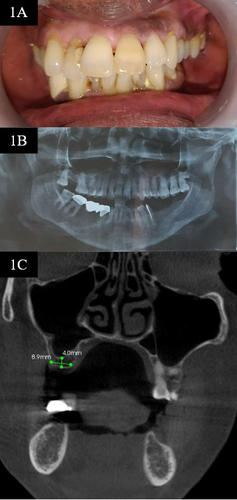-
Home
-
About JCTR
-
Gold Open Access
-
Issues
-
Editorial board
-
Author guidelines
-
Publication fees
-
Online first
-
Special issues
-
News
-
Publication ethics
-
Partners
-
Submit your manuscript
-
Submit your review report
-
Editorial Office
-

This work is licensed under a Creative Commons Attribution-NonCommercial 4.0 International License. ISSN print: 2382-6533 ISSN online: 2424-810X
Volume 8 Issue 2
Subantral sinus augmentation using a hydraulic lift system and alloplastic phosphosilicate putty followed by simultaneous implant placement for the rehabilitation of an atrophic posterior maxilla: A case report
Cathryn Beryl Padma Felix*, Anjana Kurien, Ashwin Devanarayanan, Deepak Kumar, Velliangattur Ramasamy Thirumurthy, Yuvaraja Arakonam Bindhoo
Felix et al. J Clin Transl Res 2022; 8(2):2
Published online: February 7, 2022
Abstract
Background: Tooth extraction is generally accompanied by bone remodeling and pneumatization of the maxillary sinus in the posterior region of the maxilla, which can result in a reduction in the height and width of the bone and compromise the placement of the implant. However, this anatomic deficiency can be restored via maxillary sinus elevation. Among the various surgical methods used, the indirect sinus floor elevation technique is relatively less invasive and less complex.
Aim: Herein, we present the case of a 58-year-old partially edentulous female who underwent rehabilitation of the right maxillary molar region using the indirect sinus floor elevation technique. The hydraulic lift system was used followed by immediate implant placement.
Relevance for patients: This technique incorporates the advantages of both the lateral wall and crestal approaches for sinus elevation and is associated with a lower incidence of sinus membrane perforation and minimum bone loss.

DOI: http://dx.doi.org/10.18053/jctres.08.202202.002
Author affiliation
Department of Prosthodontics Sri Ramakrishna Dental College, Coimbatore, Tamil Nadu India.
*Corresponding Author
Cathryn Beryl Padma Felix
Department of Prosthodontics, Sri Ramakrishna Dental College, Avarampalayam, Coimbatore 641006, Tamilnadu, India.
Email: cathrynfelix62@gmail.com
Handling editor:
Michal Heger
Department of Pharmaceutics, Utrecht University, the Netherlands
Department of Pharmaceutics, Jiaxing University Medical College, Zhejiang, China

